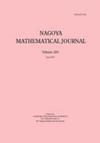如何将闭包和内部操作扩展到更多模块
IF 0.8
2区 数学
Q2 MATHEMATICS
引用次数: 1
摘要
有几种方法可以将闭包或内部操作转换为具有特定期望属性的不同操作。在本文中,我们公化了三种方法来做到这一点,从文献中吸取不同的例子,包括紧闭包,基本完全闭包和各种版本的积分闭包。在这样做的过程中,我们探索了几个这样的理想性质,包括遗传、剩余和共同的,并看到它们如何与其他性质(如有限性质)相互作用。本文章由计算机程序翻译,如有差异,请以英文原文为准。
HOW TO EXTEND CLOSURE AND INTERIOR OPERATIONS TO MORE MODULES
There are several ways to convert a closure or interior operation to a different operation that has particular desirable properties. In this paper, we axiomatize three ways to do so, drawing on disparate examples from the literature, including tight closure, basically full closure, and various versions of integral closure. In doing so, we explore several such desirable properties, including hereditary , residual , and cofunctorial , and see how they interact with other properties such as the finitistic property.
求助全文
通过发布文献求助,成功后即可免费获取论文全文。
去求助
来源期刊
CiteScore
1.60
自引率
0.00%
发文量
31
审稿时长
6 months
期刊介绍:
The Nagoya Mathematical Journal is published quarterly. Since its formation in 1950 by a group led by Tadashi Nakayama, the journal has endeavoured to publish original research papers of the highest quality and of general interest, covering a broad range of pure mathematics. The journal is owned by Foundation Nagoya Mathematical Journal, which uses the proceeds from the journal to support mathematics worldwide.

 求助内容:
求助内容: 应助结果提醒方式:
应助结果提醒方式:


